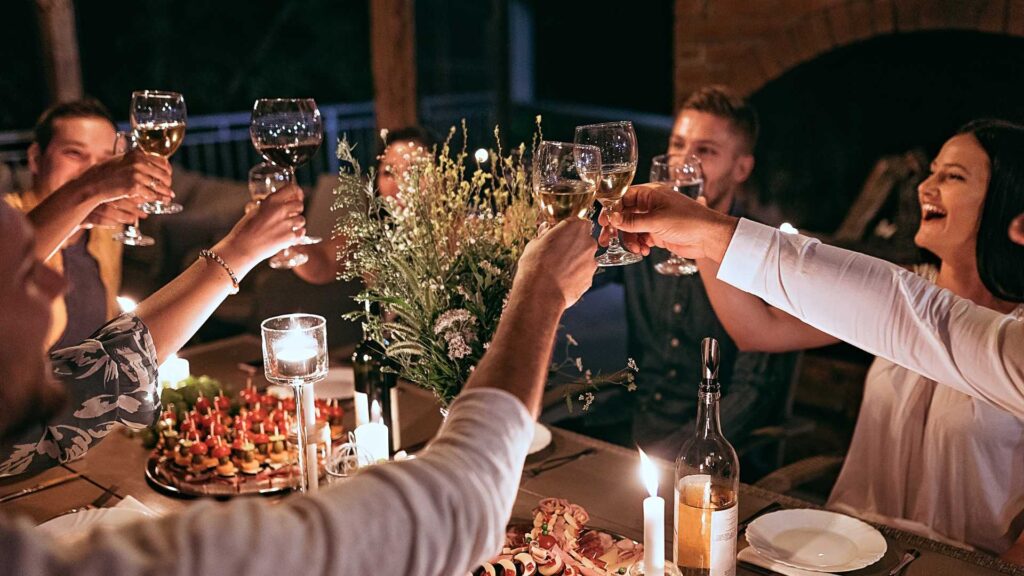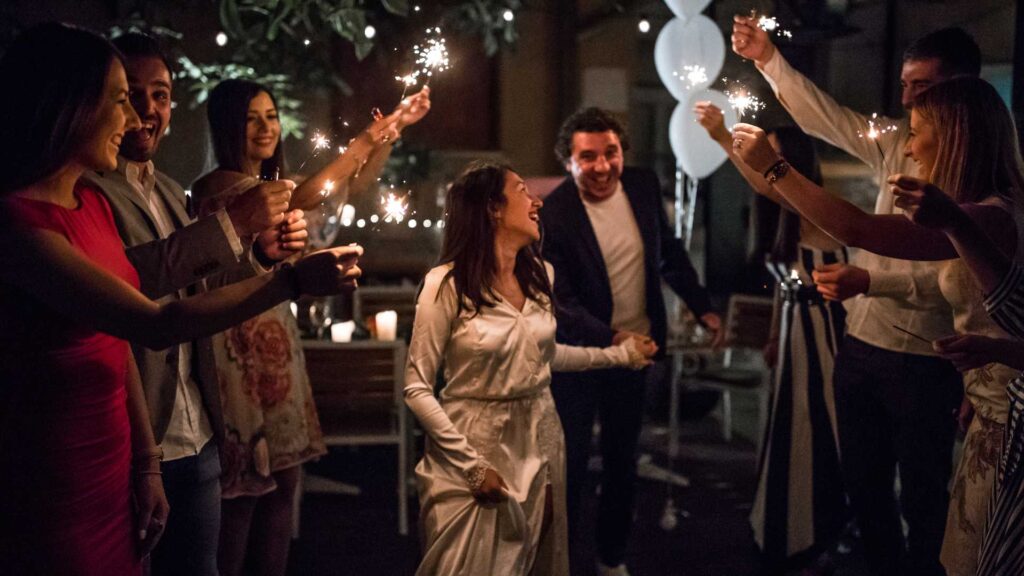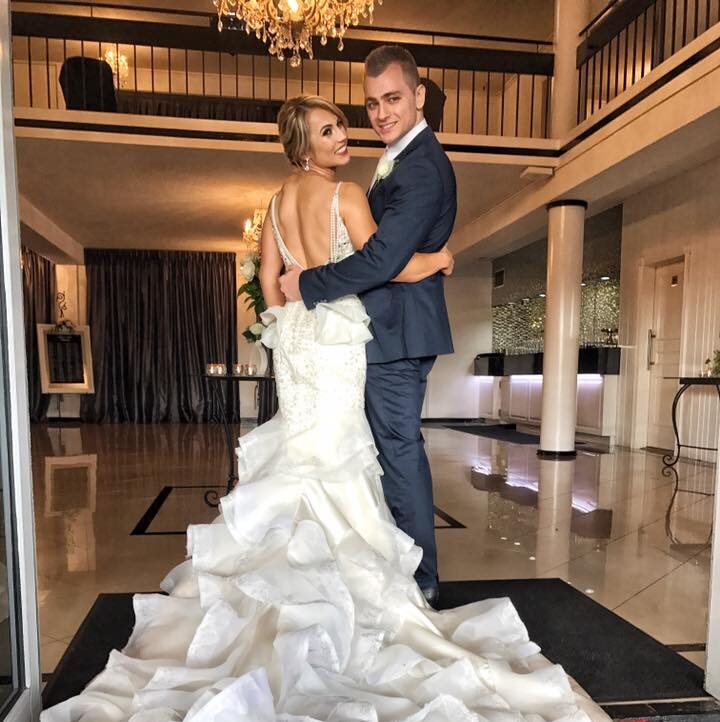Planning a wedding reception is like curating a show where every act builds up to the big finale. There’s a lot of excitement, a bit of nervous energy, and a fair bit of coordination that goes into getting it just right. When I was planning my own wedding, I remember wondering what comes first at a wedding reception. The last thing I wanted was for my guests to be bored or lost in the shuffle of what comes next.
But the key to a smooth reception lies in starting things off the right way—so everyone knows when to expect the fun, the speeches, the cake, and yes, even the dancing. While every wedding is unique, there’s a traditional sequence of events that can guide your evening, ensuring everything flows like a well-rehearsed performance.
In this guide, we’ll walk you through the first steps of your wedding reception. We’ll talk about what happens from the moment your guests walk in, right up to those all-important first dances. Let’s dive into the order of events that will keep everyone engaged and set the stage for an unforgettable celebration.
Kickstarting Your Wedding Reception: The First Moments That Set the Tone
The Cocktail Hour: Welcoming Guests in Style
When guests first arrive at your reception, the first thing they’ll probably notice is the atmosphere. You’ve worked so hard on your reception venue—now it’s time to make sure it’s ready to shine. This is where the cocktail hour comes in.
I remember when we got married, the cocktail hour was one of my favourite parts of the evening. While my partner and I were busy with photos, our guests were relaxing and getting into the celebratory mood. The cocktail hour serves as a transition, a chance for everyone to unwind and socialise before the main events unfold.
In my experience, the cocktail hour is often the first time guests can mingle with others they might not have seen in a while. It’s the perfect time for your guests to chat, grab a drink, and settle into the vibe of the event. You can personalise this time with your favourite drinks, a signature cocktail, or even a themed drink that ties into your wedding theme.
How long should the cocktail hour last?
I’ve seen weddings where the cocktail hour lasted anywhere from 45 minutes to an hour, which is a good amount of time for everyone to catch up and for the newlyweds to finish up their photos. If you’re planning a more intimate celebration or a shorter reception, you could skip the cocktail hour entirely, but I’d recommend keeping it if you have the space and time. A short 30-minute window is often a sweet spot.
What should you do during the cocktail hour?
At our wedding, we had light background music from a jazz band, which set a relaxed tone. Guests were offered an array of hors d’oeuvres, and we even had a few interactive games set up, like a photo booth where everyone could snap a picture with a funny prop. Not only was it fun, but it also kept guests entertained while we took photos.
A word of advice: consider adding a signature drink or a little personal touch during this time, whether it’s a specific cocktail that means something to you as a couple or even a small trivia game that engages guests.
How Cocktail Hour Sets the Mood for the Reception
The cocktail hour is your opportunity to establish the tone for the rest of the evening. It’s the first chance your guests have to experience the vibe you’ve set for the reception. Whether you opt for soft background music or bring in a more energetic band, the cocktail hour helps set expectations for what’s to come.
Here’s a fun example: A couple I worked with in Melbourne decided to kick things off with a surprise twist during their cocktail hour. They had a ‘chill-out lounge’ vibe, with comfy seating, mood lighting, and a live acoustic performance that was so laid-back, you felt like you were at an intimate gathering. The relaxed vibe helped set the tone for a night full of laughter, music, and dancing. By the time the formal dinner started, the energy was already buzzing.
Transitioning to the Main Reception: What Happens When Guests Arrive?
Once the cocktail hour wraps up, it’s time to guide your guests into the main reception area. This transition is key to keeping things flowing smoothly.
Reception Seating: Creating Order and Comfort for Your Guests
You want your guests to feel welcome, not confused. Having a clear and organised seating plan is crucial. No one likes standing around wondering where to sit, so having a seating chart and place cards makes the process easier for everyone.
At our wedding, we used a unique seating arrangement that doubled as a conversation starter. Each table had a little personalised trivia about the couple, encouraging guests to find their seats based on their answers. It sparked conversations and kept things lighthearted. If you’re not sure how to start, I’d recommend discussing this with your reception coordinator—they can help ensure everything flows easily.
For larger weddings, especially, this part of the evening can feel a bit chaotic if not planned well. The key is communication. Clear signage, an approachable coordinator, and place cards all help guide your guests, and they’ll appreciate the effort you’ve put into making sure they feel comfortable.
Welcome Remarks & Hashtag Announcements: Starting the Celebration with a Bang
Once your guests are seated, it’s time to officially kick off the reception. Enter the MC or wedding coordinator. This person sets the stage for what’s coming next by welcoming everyone to the celebration and possibly even announcing your wedding hashtag (more on that in a minute!).
In my experience, a heartfelt welcome speech from the couple or the parents can really set the tone. It’s also a nice gesture to acknowledge the importance of the day and thank your guests for attending. At my wedding, we made sure to do this just before our grand entrance. It gave us a chance to express our gratitude and get the crowd excited for what was coming next.
If you’re thinking about using a wedding hashtag (which I recommend!), now’s the time to announce it. Make sure to encourage guests to share their photos on social media throughout the night. You’d be amazed at how many beautiful, candid moments get captured that you might miss while enjoying the celebration!
The Wedding Party Entrance: Building the Anticipation and Energy
Wedding Party Entrance: Making It Memorable
Once your guests are settled and the reception is officially underway, it’s time for the wedding party to make their grand entrance. This moment is all about building anticipation, creating energy, and setting the tone for the rest of the evening.
When we planned our wedding, my partner and I really wanted to bring some fun and excitement to the entrance. We didn’t just want the bridal party to walk in like it was another day at the office—we wanted everyone to feel the buzz and know that this was a night to remember.
Typically, the wedding party enters first, and it’s not unusual for them to make a bit of an entrance. The order usually goes something like this: ushers (if announced), followed by bridesmaids and groomsmen, then the Maid of Honour and Best Man. Everyone’s walking in with a smile, but don’t be afraid to get creative. I’ve seen couples do everything from quirky dance moves to hilarious poses as the wedding party enters.
A couple I worked with in Melbourne took their entrance to the next level by incorporating a fun little surprise: each bridesmaid and groomsman had to dance or perform a fun move before taking their place. It had everyone in stitches and really loosened up the crowd, setting a lighthearted tone for the evening ahead.
Newlyweds’ Grand Entrance: The Moment Everyone’s Been Waiting For
Now, for the most highly anticipated moment of the evening—the newlyweds’ grand entrance. This is the time to shine, and it’s your moment to show your guests how excited you are to begin your married life.
We were no different! When my partner and I entered the ballroom, the energy was electric. The guests were cheering, clapping, and so excited for us. It was exactly what I had hoped for. This moment marks the beginning of the celebration, so make it count. Choose a song that reflects who you are as a couple. Whether it’s a romantic ballad or an upbeat anthem, your song will set the vibe for the night.
For us, we went with a fun, high-energy song that had everyone on their feet. I’ll never forget the look on everyone’s faces—there was so much joy in the room. After all, this moment is all about celebrating you and your new journey together!
If you’re unsure what song to choose, think about something that feels personal or represents your relationship. A couple I know used the song “Ain’t No Mountain High Enough,” and it was a huge hit. The energy from the song flowed right into the reception, making the moment feel even more powerful.
What Comes Next: The First Formalities After the Entrance
The First Dance: A Symbol of Your New Beginning
After the grand entrance, the first dance is often the next formal event on the reception timeline. It’s not only a tradition, but also a deeply meaningful moment that symbolises your first steps as a married couple. This is one of those moments that will be remembered forever.
For us, this was a pretty special part of the day. We decided to keep it simple and sentimental. We didn’t do any fancy choreography, just a slow dance to a song that held meaning for us. It was a quiet, intimate moment amid the buzz of the reception, and it was the perfect way to celebrate our new journey.
Now, I know some couples like to get fancy with their first dance. Some plan elaborate choreographed routines, while others might want to pull off a bit of a surprise for their guests. One couple I worked with in the Yarra Valley hired a dance instructor for a few lessons, and they performed a stunning waltz that left the guests in awe. But whether you keep it simple or go for something more elaborate, the first dance is a beautiful opportunity to connect with your partner while everyone else watches and cheers you on.
Welcome Speech and Blessing: A Heartfelt Moment of Gratitude
Following the first dance, it’s time for the welcome speech or blessing. Traditionally, this is when either the father of the bride or the couple gives a few words of gratitude. It’s an important moment to express your thanks for the people who have supported you along the way.
At our wedding, my father gave the speech. He didn’t just thank our guests for attending; he also shared a few heartfelt memories, which made everyone laugh and tear up a little. It was a moment of warmth that set the tone for the night. I can’t tell you how many people came up to me afterwards and said how special that speech was. It’s the kind of thing that stays with you long after the wedding.
Of course, the speech can be given by anyone—the couple, the best man, or even the wedding coordinator. Just make sure that whoever speaks is comfortable and speaks from the heart. You can also follow this with a blessing, whether it’s religious or just a general wish for love and happiness.
If you’re not sure what to say, here’s a tip: Write from the heart. You can make it lighthearted and fun, or you can go for a more sentimental approach—either way, it’s your moment to thank everyone and celebrate love.
Your Wedding Reception Timeline: From Start to Finish
Key Milestones to Include in Your Reception Timeline
Now that we’ve covered the first part of your reception, let’s talk about the overall flow of events. A well-organised timeline ensures that everyone knows what’s coming next, and it helps avoid the dreaded “What happens now?” moment. Here’s a basic wedding reception timeline to get you started:
- Cocktail Hour (45 minutes – 1 hour)
- Guests mingle, enjoy drinks, and snack on appetisers.
- Light entertainment like music or games.
- Guest Seating (5-10 minutes)
- Guests are directed to their assigned tables.
- Wedding Party Entrance (5-10 minutes)
- Introduction of wedding party members and their fun moments.
- Grand Entrance (5 minutes)
- The newlyweds make their grand entrance, greeted with cheers.
- First Dance (3-5 minutes)
- The couple shares their first dance together.
- Welcome Speech & Blessing (5-10 minutes)
- Either the couple or a family member gives a speech of thanks and a blessing.
From there, your timeline will typically flow into dinner, speeches, cake cutting, and dancing. Of course, every wedding is different, and you’ll want to adjust this based on your preferences.
Customising Your Reception for Maximum Enjoyment
Every couple is different, so don’t be afraid to break from tradition! Whether it’s incorporating fun reception games or introducing unique wedding reception ideas, make sure your wedding reflects you and your partner’s personality.
A couple I recently worked with in the Dandenong Ranges decided to add a fun twist by including a trivia game about the couple during the reception. Guests were given cards with trivia questions, and the winning team got to take home a special prize. It was a hit and got everyone laughing and talking!
Key Takeaways for a Seamless Wedding Reception
- Keep the flow moving: From the cocktail hour to the grand entrance, pacing is key to making sure your reception doesn’t drag.
- Incorporate personal touches: Your wedding should feel like you. Whether it’s through a first dance, speech, or creative reception games, personalise it to your tastes.
- Work with your wedding coordinator: They can help you structure your timeline, so everything runs smoothly and on time.
Let’s Get Straight to the Point
Planning your wedding reception? The key to a smooth celebration lies in starting with the right sequence of events. Begin with a cocktail hour where guests can mingle and relax while the couple finishes photos. Next, guide guests to their seats, followed by the formal introductions of the wedding party. The newlyweds’ grand entrance kicks off the main celebration, often followed by the couple’s first dance and a heartfelt welcome speech. A well-structured timeline keeps everything flowing seamlessly, from dinner to speeches to dancing. Personal touches like custom seating charts or reception games can enhance the atmosphere, making the evening unforgettable. Your wedding coordinator plays a crucial role in keeping things running on time, ensuring your big day is nothing short of perfect.




